- Certainly the Great East Japan Earthquake and Tsunami (3.11) dealt a severe blow to the folk arts of the Tohoku region. At the same time, we are seeing a rediscovery of the importance and necessity of these folk arts, as people and communities have found strength and inspiration in them to work with new spirit toward recovery, in their lives and for the region. For many years now you have been making video recordings of the folk arts, primarily in Iwate Prefecture and you have also been uploading many of the videos on YouTube. It is a wonderful video archive you have created. In this interview we would like to ask you about your activities and your observations about the role of the folk arts in the areas stricken by the 3.11 disaster. When did you begin doing video recordings of the folk arts?
-
Originally I am not from Iwate, but moved there from Tokyo around 1975 and started a film production company, so it was a little after that when I began. It was after coming to Iwate that I encountered the folk arts for the first time and it was a truly surprising discovery for me because I had no idea such arts existed. So, I decided this would be an important thing to document. Until then we had been in the era of film, which made documentation of that type more difficult, even if you had the desire. But, just around that time we were entering the video era, so it was much easier to get the means to document these performing arts. I was living in the city of Kitakami in Iwate at the time and I began by doing video recordings of the local folk rituals and events happening in my vicinity.
From the latter half of the 1980s I began to get requests from the private-sector TV stations in the region to film video footage for programs they would produce on the folk arts or festivals. In those cases, it was no longer just a matter of filming what I saw, because I would be working with specialists in the field and it became a learning experience. And the more I learned the more I got into the folk arts seriously.- Now you work under the name of your organization the Tohoku Bunkazai Eizo Kenkyujo (Tohoku Cultural Property Film Institute). Would you tell us how you came to establish this institute and give us an outline of your activities?
We established the institute in 1998, so it has now been more than a dozen years ago. We got together four video production companies in the Tohoku region and established the Tohoku Cultural Property Film Institute as an incorporated company. We established it out of a sense of the importance of recording the folk arts, folk rituals and intangible cultural properties of Tohoku and gathering these videos together as a resource for film production companies for creating contents. However, it turned out to be a difficult enterprise to pursue by a private-sector company, so I ended up being the only one remaining in the company.
My activities with my institute include recording events on commission from local governments to, creating contents and uploading them on the Web so as many people as possible can re-discover these folk arts and folk rituals that constitute Japan’s “grassroots culture.”
I am not an academic researcher like the one’s that staff most institutes, my specialty is video filming and documentation, so it is my hope that the material I film will help forward research in our field. If you are doing comparative studies of culture, for example comparing the cultures of Northeastern (Tohoku) and Western Japan, it is much easier if there are videos accessible to the public. By uploading videos onto You Tube we make it possible for researchers and people from foreign countries to access our archive and see what these Japanese folk arts are like. However, since everything is in Japanese it is surely a bit difficult for foreigners to get a full grasp of what they are seeing.
Although the archive is incorporated as an “Institute,” it is in fact solely my own project and all of my time is taken up now with filming and gathering video recordings, so I honestly haven’t been able to organize it all properly as an archive and make it all accessible to the public in a systematically organized form.- Can you tell us what the scope of the archive is and about how many videos it consists of?
It centers mainly around the folk performing arts of Iwate Prefecture but there are also some from Akita, Aomori and prefectures Miyagi and a few from Yamagata prefecture. Unfortunately, I haven’t been able to go to Fukushima Prefecture yet to gather material. Also, when there are special opportunities, I got to the other regions of the country to film individual events. I don’t know exactly how many video recordings I have in all [in the total archive]. There is some overlap, and some that record the changes in a particular art over the years. But, in round numbers, I believe there are over 1,000 folk performing arts that we have video recordings of. Iwate Prefecture that we have been recording on an ongoing basis and a variety of other kagura traditions such as the Kuromori Kagura from the city of Miyako, Iwate, Unotori Kagura and the Ogatsuhoin Kagura, as well as festivals and rituals. At first we were only able to upload videos of less than five minutes [on YouTube] and the video definition was poor, but the definition has gradually gotten better and recently we are able to upload videos of an hour in length, so there is no longer a need to break the videos up into short parts. Anyway, I have worked long and hard to upload the videos until now.
Gathering [video recording] materials and creating a formal archive are two rather different jobs, and true archiving is a job that can’t be done without a large concentrated effort. I am one who prefers field work, so I go to meet with the people who perform the folk arts and the people of the communities that have these arts and talk with them and record the exchanges we have, as well as filming the actual dances or festivals, etc. So, what I am doing is not shooting and editing recordings of the dances, etc. as works of performance art but recording the entire event [including interviews with the people involved] in documentary type video recordings.- Listening to what you say, it appears that you are not only recording the arts themselves [the physical expression involved in the dances and other arts] but also the societal context within which they are performed.
That is true. The thing I am most concerned with is the involvement with the community. In the past people talked about filming the art, but if that is all you are concerned with, it would actually be more informative if, for example, you had the artist perform the dance without the costume on, so that you could see the physical movement and poses more clearly. But, my main objective is to record more than the performance art itself. I want to record the background as well, which includes the social context and the involvement with the community at large. My approach deals with the idea that, in fact, the most important aspect of folk arts is the way they are received by the communities or the region. For example, the toramai (tiger dances) are performed during festivals, so I believe to show them properly you need to record footage of the festival as well.- In the case of a folk art like Kuromori Kagura where the performance troupe travels from town to town staying in kagura yado (the private homes in a town or village that serve as “kagura lodgings” where the touring kagura troupe is given room and board and a place to perform during their stay), how do you go about recording it all on video?
In the case of Kuromori Kagura, due in part to the request of the local government, we have been filming it on a continuing basis over many years and I try to include as much as possible in the filming, beginning with things like the preparations being made by the people of the “kagura lodging” to receive the kagura troupe, such and preparing the meals before the troupe’s arrival. There is also a ritual that is performed when the kagura troupe arrives at a town or village, so I record that on video too.
Today, with the improved transportation and road infrastructure in this once remote region, the kagura lodgings are used less often, because the troupe can now drive to the village, perform and then drive home in the same day. But, that takes most of the interest out of the kagura tour. Staying overnight at the kagura lodging is a very important part of the so-called mawari kagura (traveling kagura). For one thing, staying in the same inn together builds bonds between the members of the kagura troupe. In the evening after performing they drink together, then in the morning they get up and the master performer leads them in practice sessions. In the old days they could only practice when they were together on tour. We have recorded the various aspects of this time-honored tradition of performing, staying the night at the kagura in and then practicing together the next morning.
Today, the kagura is usually performed on Saturdays and Sundays and the members of the troupe go home by car without staying the night after the performance. So they can’t drink together like before. And, since they don’t spend that time drinking together, you naturally don’t have the depth of conversation and storytelling you once had. The community and the former kagura lodgings that used to receive them come to expect that [no stay-over] as well. If there is a stay-over the host community opens up, but that can’t happen without the stay-over. Without the stay-over, the kagura is performed in a community center facility instead of a kagura lodging and after the performers leave the people of the community go home early too, without any prolonged gathering. So, there are fewer and fewer opportunities to experience the old atmosphere of the “traveling kagura.” Now I realize how lucky I was to have been able to record that experience on-site and in person [laughs].- Watching the videos where you documented [the traveling kagura], we see the kagura troupe performing on the tatami floors of the living rooms of the private homes [that served as kagura lodgings] with the people of the community sitting around close to the performers and then enjoying drinks together around the heated kotatsu table. You can’t get that kind of atmosphere at a public hall or community center, can you?
That’s true. But, another difficulty is whether today’s young people can appreciate and get into the old way of doing it. I can understand why people can’t open their homes as kagura lodgings like they used to. But without the kagura lodging stay-over, they will never get a chance to appreciate the best parts of the old traditional way. At the risk of being understood, I would say that if it comes down to a situation where you are just showing a performance of the dance itself, people might even say they aren’t interested in seeing simple performances like these. Especially in the case of “night kagura,” I would say that to really appreciate it and enjoy it you have to get into the entire atmosphere gathering and the place rather than simply watching the dances. It may sound like an exaggeration, but I would say that the moment shared by the kagura performers and the people of the community is like a communal sharing of the fact that they are all alive together in the here and now. In the end, the best thing about night kagura is that by the time it is over, everyone is joined in the same spirit, but it may be difficult now to ever bring that kind of era back again.- Would you tell us about the unique characteristics of Kuromori Kagura?
Kuromori Kagura has a history of about 500 years, I believe, and as I mentioned earlier, it is performed by a traveling troupe of performers covering a large area of the Pacific coastline over the course of a few months in what amounts to a form of pilgrimage tour. The troupe carries with them a shishigashira (lion mask) called a Kuromori Gongen that is imbued with a scared spirit. Normally, there is a different kagura for each realm performed by its own group of maintain aesthetics, so kagura groups couldn’t tour to other areas outside of their own. But, the old Nambu-han lords made an exception and granted the Kuromori Kagura official permits to tour. Doing kagura meant earning money, so kagura troupes could sue each other for invading their territory, but the Nambu-han rulers did away with that system to enable the touring by Kuromori Kagura. Because of that special right, kagura performers from other troupes came to join Kuromori Kagura, which lead to a selection of the best performers congregating in Kuromori Kagura so it became a very elite group.- A kind of all-star team.
Exactly. So, it was said in the old days that if you became the Kuromori Kagura dotori (the drummer who leads the kagura ensemble) and performed for a few years you could earn enough to build a kura (a private storehouse that is also a status symbol of the well-to-do). So, as long as they were being paid like that, they had to be able to really entertain the people of the community, the audience, and they also performed the rituals that were considered their responsibility as men who had undergone spiritual training. In olden times, because the boundary between the indigenous Japanese animist Shinto religion and Buddhism was blurred, the kagura performers could also do Buddhist ceremonies. And, they would receive gift money for performing rites to bring good harvests for farming communities or good catches for fishing communities or rites to ward off evil or ceremonies for the deceased.
In one region, I heard that the men would leave the village to go on tour [as kagura performers] for more than half the year during the farming off-season. They would leave as soon as the harvest was complete. In the post-World War II era when there was little entertainment, they would of course do kagura but they also began to do plays as well. The basic format of kagura is to do ritual dances rites for about the first two hours, which was of course important, but by then the audience would be calling out, “Come on and start the play!” [laughs] So, it apparently reached the point where some troupes quit the kagura and started doing the plays from the outset. That seems to show that the people of the communities were looking to kagura not only for its spiritual and religious functions but also for entertainment.
Apparently Kuromori Kagura also went through a period where the more entertaining dances became the mainstream and the overall repertoire diminished, but that trend reversed and much of the old repertoire was revived from about 30 years ago. I think most researchers see kagura as primarily a tradition of religious rites and dances for the gods, but as someone who has seen the actual state of kagura in the villages, I would like the researchers to know more of the entertainment side of kagura.- Although Kuromori Kagura wasn’t affected much by the March 11th 2011 Great East Japan Earthquake and Tsunami, the very foundations of some other folk arts in the coastal region were devastated. One of them was Ogatsuhoin Kagura, which had most of its ritual masks and costumes swept away by the tidal wave. But just two months later the people of the area were saying that they wanted to see kagura again, and that started efforts to restore the art. This made us see how truly important the local folk arts are to the people of this region.
Why is this? It seems to be a bit different from praying to a god or Buddha. I can’t help but feel that they are doing it for spiritual reasons within themselves. Or, I could say to confirm within themselves what their true self is. And, thinking that way, I feel certain that they are not simply doing it for the enjoyment of the art.
I once heard this story from the folk arts researcher Hiroyuki Hashimoto. There is a toramai (tiger dance) musician who lost his mother and his 16-year-old daughter in the 3.11 tsunami. He remained overcome with grief for the longest time, but since he knew that his daughter had loved it when he played the flute, he began to play again several months later, shedding tears as he played. Originally the toramai flute is not played for the repose of the deceased, but in the efforts for the recovery of the stricken region, it took on a memorial service aspect. His flute had changed from mere musical accompaniment to something that soothed his soul.
As this story indicates, I feel that the 3.11 disaster made the arts something that can quiet the troubled soul, that it has the power to quiet the incomprehensible feelings within. By devoting oneself wholeheartedly to one’s art, the artist can slowly calm his troubled mind and emotions and regain an inner quiet it seems. I arrived at the feeling that the arts can make one live positively, and for that reason, that should be their role now.
The place where that toramai and festival were held was washed away by the tsunami and everything was lost. Bringing back the festival and the toramai is not something they are doing for the purpose of reminiscing about times past but something that must be done for everyone to begin to move forward positively again. And, if they don’t do it, it will probably be lost. It would become like a kite whose string has been severed. Because the actual situation now is that the place where they had lived is now gone and they are indeed all like kites with severed stings that have been blown away from their homes.
As for Kuromori Kagura, there were worries that because the kagura lodgings were damaged it would not be possible to raise enough money for next year’s tour, but looking at the situation this year it seems to me that things will be all right. The places that were washed away in the tsunami won’t be available as in the past but there is a sufficient core of lodgings and if everyone rallies from there it should be possible to do something.- Since 3.11, I think the video library you have created is more valuable than ever. Have there been any inquiries from the local governments or public agencies about making a formal archive of all this material?
No inquiries at all. There are many people who now that I have been making these video recordings, but I haven’t heard from anyone about a desire to create an organized folk arts archive, And it would be completely impossible for me to do it alone with my own resources.
Saying archive is easier than creating one. For beginners, the types of videos I have range from early VHS up through Betamax, 3/4 inch, Betacam, Betacam SP, Digital Betacam, Betacam SX, then on to DV Cam and HDV. After the emergence of AVCHD a few years ago I have been recording on hard discs.
We have to think about what to do with all these videos and how to pass them on to the next generation. If it were the old days when there was only film, it might be enough for someone to just diligently spend hours sorting out the mess, but with digital data it is rather more difficult, I believe, because if it isn’t organized right it could be very difficult to find and access things.- It will take a professional, won’t it?
Yes, it will. We have to think seriously about this, including people on the national level. As for my own capabilities, I am already at my limit. I believe this type of film and video documentation of the folk arts exist all over the country, but I don’t think people are aware of the status of what exists.
There is so much that needs to be recorded that I don’t have the time to make such an archive, and even what exists may soon be scattered and lost or be inaccessible because of copyrights. In order to make effective and optimum use of theses resources, I hope some public agencies or organizations will begin considering the possibilities for creating such an archive as soon as possible. One of the problems is perhaps the tendency for such video documentation to be considered less important than works of art. If a discourse concerning how to preserve and make use of video documents of folk performing arts is not undertaken from a broad perspective, I fear that this fundamental Japanese culture will not be carried on in the future.- Has there not ever been any discussion about creating such an archive?
I don’t think there has ever been any discussion on the nationwide level about creating an archive. In the past, the Folk Arts Council of the Tokyo Cultural Properties Research Institute put together a guideline for the recording of folk performing arts by film/video production companies. At that time too, it took a long time to reach agreement on things. A good amount of time has passed since then and today it is much easier for people of the general public to use video equipment, so I believe there is a need to consider setting new standards on a wider scope for the documenting of folk performing arts.- By the way, you went along when the Japan Foundation organized a tour of Kuromori Kagura to Russia (Oct. 2011). What was your impression of the way it was received there?
I believe the people in Russia saw it as performance, without the spiritual of faith aspect attributed to kagura in Japan. It was the same in the performances in France where it was greeted with comments to the effect that people felt they had seen numerous types of new movement within the dances, or they felt that they has seen an entirely new kind of dance and new sense of rhythm. I think they found these things very interesting.
When the dance would reach a strong rhythm there would be applause at places we didn’t understand the reason for it, and there were times when it grew to a clapping in beat with the music. When we watch kagura in Japan, especially the ritual dances, we may not be in a formal sitting position but the audience tends to sit respectfully and receptive to the spiritual blessing the dance is meant to include. But, that is not the way those foreign audiences responded. I believe they were good at finding the unique qualities of the dance and the rhythms. It was as if they felt, “Wow! I didn’t know kagura could have such violent movement.” That was the response I sense.- I have noticed that when you talk about the folk arts you use the term kiso bunka (fundamental culture/art). Why is that?
What I call fundamental culture is the culture and arts that forms the cultural base of the people living in a particular area. And, naturally, the fundamental culture should be different in different regions. In ancient times, it was people of the same tribe or ethnicity that settled in a given village (area), so their fundamental culture strongly reflected the unique customs of that tribe or people.
Therefore, there are parts of it that is hard for others like us to understand, and then the performing arts come in on top of this fundamental base. The arts would often be things that came in from outside the area and then may have undergone changes to fit the local customs. Then, over long period of time it becomes integrated into the area’s “fundamental culture.” At the same time, things that had reach a state of completion as an art within local rituals and the like would then spread to other areas where they would be assimilated with perhaps new visual aspects and way of performing, I believe. So, I think it is difficult to talk about those type of arts being performed here and there today as “folk arts,” and that is why I use the term fundamental arts.- Since last year’s 3.11 disaster, there has been a lot of discussion from a number of quarters about what the arts and culture can do for society. And in the course of this discussion I think many people have realized that the folk arts that have been handed down for generations as the fundamental culture of regions are actually a part of the daily life of the people and have existed alongside the earthquakes and tsunamis and famines of the past.
The Sanriku coast struck by the tsunami on 3.11 is a coast with a long history of tsunamis and has suffered devastating damage the same as this time. Although there are still things we don’t understand about how these folk arts and festivals have survived the past disasters, but we do know that the wealthier citizens made efforts to help the people of their communities in times of disaster. It wasn’t because those wealthy citizens were so great or magnanimous but because society was such that if they didn’t help the suffering people that next they would lose their reputation and the trust of the people and eventually lose the source of their wealth. So, as things gradually got better after a disaster, they would say, “OK, let’s invite the kagura here, or, let’s hold a festival next year.” I believe that is probably the way things went.
Rather than being the power of the arts themselves, I believe it was a case of the existence of the arts gave the people something to work toward and a means for them to draw inspiration from their efforts and spirit. I believe that in the process of seeking some way to leave a heritage of their lives and existence for the future, it was a very natural response to turn to the arts.Kuromori Kagura
The Kuromori Kagura is centered on Kuromori Shrine located on Mt. Kuromori in Miyako City, Iwate Prefecture, and it is classified as a yamabushi kagura. The yamabushi are mountain ascetics, and this category consists of kagura they performed as a means of spreading their faith during the early modern era in Japan. It is precious as a folk performing art that is still practiced in the present day by processions that visit from village to village in an expansive area of the Rikuchu Coast of Iwate Prefecture ranging from a part of the locale known today as Kuji City in the north to a part of Kamaishi City in the south, proceeding from south to north and then north to south in alternating years. This is a region where numerous kagura have been passed down since the early modern era, and the procession makes short visits to the shrines and hamlets those kagura belong to. The Kuromori Kagura has assembled the most talented dancers and musicians from among these local kagura performers, who together engage in the long procession that takes a period of some months. One of the distinctive characteristics of this kagura is the way it has fused a spirit of reverence for Kuromori Shrine, a sacred mountain site linked to the lineage of Japanese mountain worship, with fishing village culture founded upon the fishing carried on along the Iwate coast since ancient times, their combination producing the unique, heroic dance and musical accompaniment of the Kuromori Kagura. This can therefore be considered the preeminent kagura of the region. There is no instance of kagura anywhere else in Japan that conducts a procession over such a wide range and such a long period of time. In recognition of this and the continuation into the present day of precious folkways that are enmeshed in the ways of life along the coastal region, the Kuromori Kagura was designated an important intangible folk-cultural property by the national government in 2006. The Kuromori Kagura procession (jungyo) begins with the ritual of commencing the dance (mai tachi) on January 3, then makes the rounds of locations on the Rikuchu Coast known as kagura lodgings (kagura yado) until March. The kagura lodgings are most commonly provided by important local people, and it is not just the families and relatives of those households but also other local residents that gather there to enjoy the kagura. Kagura embodies a world-view that is inextricably linked to the locality, and kagura performances invariably include a dance manifesting the presence before the audience of a divinity who purifies the world and promises blessings. In the Kuromori Kagura, this deity is in the lion masks referred to as “manifestations of the deity” (Gongen-sama), and a dance of the manifested deity (Gongen mai) is always included in the ritual of commencing the dance and in the dancing entry into the lodging (maikomi). The Kuromori Kagura also includes such representative pieces as the dance of the mountain deity (yama no kamimai), the dance of Ebisu, a deity who promises bountiful catches of fish (Ebisu mai), and other such pieces that are closely tied to ways of life in the local communities, in addition to the kagura associated with the Imperial court (mikagura) that represent myths passed down in every part of the country. There are also dramatic pieces with a strong story element, which are referred to as shikumi, warrior dances (bushi mai) based on the war between the Minamoto and Taira clans and other historical legends, and other audience-pleasing performance pieces that enthrall everyone from adults to children. What sustains the Kuromori Kagura, therefore, is the kagura performers, who have historically taken on the responsibility for carrying on this precious performing art, and the people of local communities who have provided the kagura lodgings and received the kagura performers. The Kuromori Kagura can be considered the combined form taken by the refined essence of these people’s hearts and minds together with the traditional culture that is a living presence along the Rikuchu Coast.
(From Japan Foundation Website sources)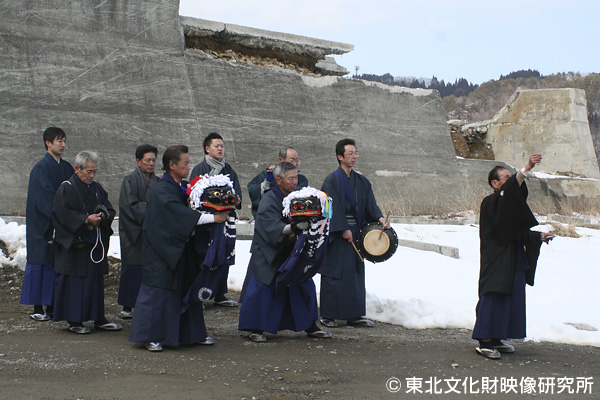
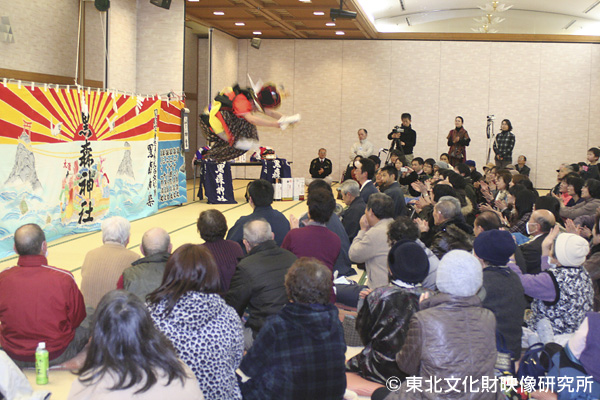
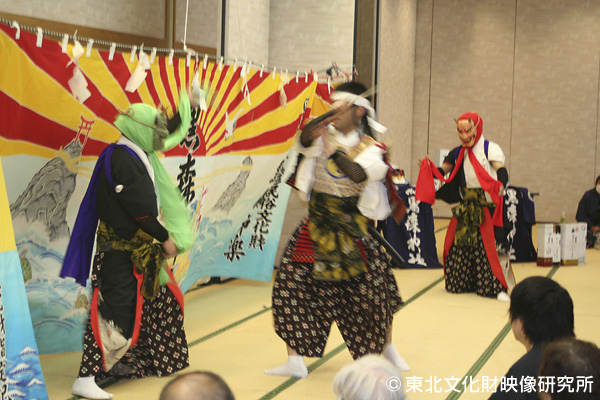

Kagura nenbutsu of Kuromori Kagura
(March, 2012 at Taro, Miyako, Iwate Prefecture)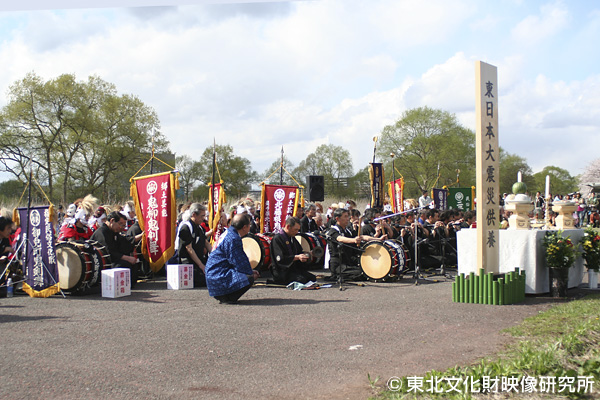
“Oni-kenbai Dance” of Kitakami, Iwate Prefecture
Dance of memorial service for victims of the Great East Japan Earthquake and Tsunami by KItakami Oni-kenbai Association (April, 2011)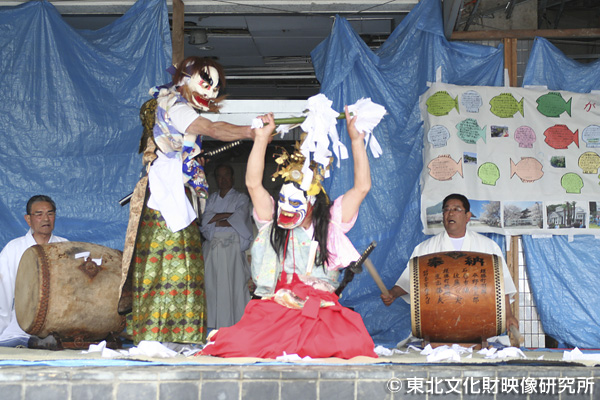
“Ogatsu Hoin Kagura Dance” of Ishinomaki, Iwate Prefecture
Dedication to kagura dance at Ogatsu Reconstruction Market (May, 2011)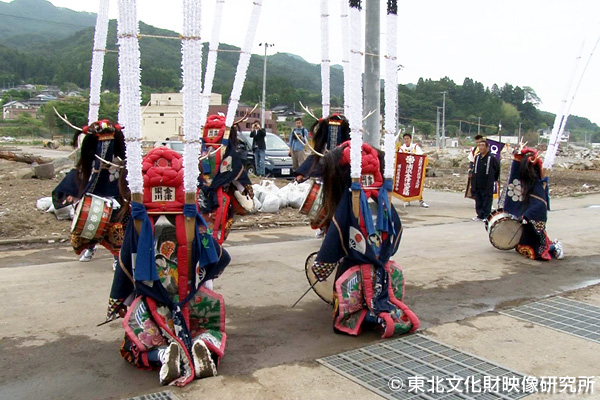
“Urahama Shishiodori Dance” of Ofunato, Iwate Prefecture
Buddhist memorial service of the Great East Japan Earthquake and Tsunami (June, 2011)Related Tags
Takeshi Abe
A year after the Great East Japan Earthquake and Tsunami People find strength in the region’s folk arts

Takeshi Abe
The Tohoku (Northeast) region of Japan’s main island that suffered such devastation in the Great East Japan Earthquake and Tsunami (3/11/2011) is also a region known for its wealth of folk arts such as “kagura” ritual dances performed since ancient times as offerings to please the patron gods of local shrines, “shishiodori” dances performed with a headdress modeled after a stag deer’s head and horns, the explosive “kenbai” dances performed while wielding a sword and stamping firmly on the ground and the “toramai” dances performed in tiger-like costume.
“asapro Mukei Bunkazai Eizo Library” (Asahi Products Intangible Cultural Assets Video Library)
https://www.youtube.com/user/asaproabe
Interviewer: Torao Osawa [Researcher, NLI Research Institute]

